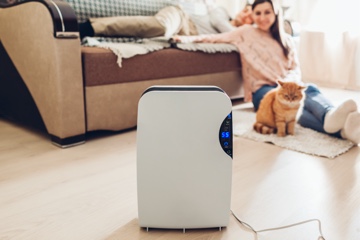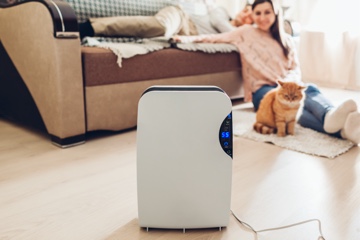

Your home is your palace of tranquility. It’s where you raise your family, take the time to focus on your personal well-being, and generally relax from the stressors that are often waiting right outside your door. And that’s why it’s so important to keep it as healthy as possible.
After all, it often takes greater focus and effort to truly optimize your indoor air quality in an impactful way, and that’s why we’re here with five easy tips for achieving a healthy home environment …
1. Control Indoor Moisture
Particularly in Florida, it can be difficult to combat persistent humidity and its propensity for entering your home no matter the time of year. And the reason moisture can be hazardous? It invites other unwelcome airborne allergens, as well as mold growth.
Luckily, according to the Centers for Disease Control (CDC), there are many easy ways to prevent the indoor relative humidity from exceeding 40%–60% in your home. Some common ways include installing a dehumidifier, using exhaust fans, repairing water leaks around the home, and using caulk to seal cracks around your windows or doors.
2. Change Your Filters
Generally speaking, you should change the air filter in your HVAC system every three to four months, as the more you filter traps allergens and contaminants, the more it becomes clogged and functions less efficiently.
And if you want to go the extra healthy mile, a high-efficiency particulate air (HEPA) filter is an excellent choice for the next time you’re scouring the market for a new filter.
“This type of air filter can theoretically remove at least 99.97% of dust, pollen, mold, bacteria, and any airborne particles with a size of 0.3 microns,” the Environmental Protection Agency (EPA) explains.
3. Invest In An Air Purifier
“If you’re allergic to indoor allergens and can’t control the source of the problem — for example, you’re unwilling to give up your family pet — it may help to use an air purifier,” Harvard Health Publishing recommends.
Designed specifically to remove contaminants from around the home, an air purifier contributes an additional filtration barrier between you and other airborne particulates, aiding the efforts of your already-present HVAC filter.
4. Improve Your Home’s Ventilation
Good ventilation means good indoor air quality, as a home with an air environment that is too tightly sealed may actually be apt to trap more allergens and contaminants than you realize.
In fact, the EPA has specified that “ventilation […] helps remove or dilute indoor airborne pollutants coming from indoor sources. This reduces the level of contaminants and improves indoor air quality.”
5. Mind Your Home Materials
Other materials that are already inside of your home may act as an additional obstacle to optimizing your air quality. For example, paints and certain chemical cleaners can slowly break down into volatile organic compounds (VOCs), and thus should be both stored securely and kept out of your primary indoor living areas for your safety.
Additionally, the Asthma and Allergy Foundation of America (AAFA) recommends using washable curtains, switching to wood flooring, washing rugs weekly, and more in order to clean out trapped pollutants that can become resuspended during your daily activities.
Not quite sure what the current status is of your indoor air quality? Or are you unsure as to what you should tackle first when it comes to implementing these recommendations? Luce Air Quality can help!
With a proven commitment to providing exceptional technical expertise, customer service, and more, we can investigate your home and provide you with trusted solutions. Contact us today by calling (904) 803-1014 or emailing info@luceairquality.com to schedule an investigation!


